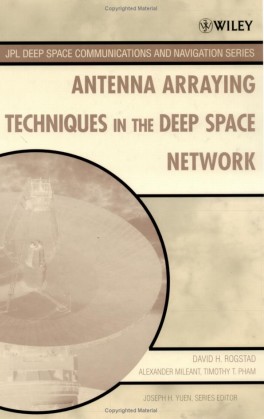Antenna Arraying Techniques in the Deep Space Network

By: David H. Rogstad, Alexander Mileant, Timothy T. Pham
Product Details
Hardcover: 166 pages
Publisher: Wiley-Interscience (June 12, 2003)
Language: English
ISBN-10: 0471467995
ISBN-13: 978-0471467991
Table of Contents
Foreword.......................ix
Preface...........................xi
Acknowledgments........xiii
Chapter 1: Introduction........................1
1.1 Benefits of Arraying .......2
1.1.1 Performance Benefits........................2
1.1.2 Operability Benefits ..........................3
1.1.3 Cost Benefits .......3
1.1.4 Flexibility Benefits............................4
1.1.5 Science Benefits .4
References...4
Chapter 2: Background of Arraying in the Deep Space Network ......7
2.1 Early Development..........8
2.2 Current Status of Development ................9
2.3 Anticipated Applications with Current Capabilities .......11
References.12
Chapter 3: Arraying Concepts .........13
3.1 An Array as an Interferometer.................13
3.2 Detectability ....................16
3.3 Gain Limits for an Antenna and Array..17
3.4 System Temperature....18
3.5 Reliability and Availability........................20
References.24
Chapter 4: Overview of Arraying Techniques...........25
4.1 Full-Spectrum Combining (FSC) ............26
4.2 Complex-Symbol Combining (CSC) ......27
4.3 Symbol-Stream Combining (SSC)..........28
4.4 Baseband Combining (BC).......................29
4.5 Carrier Arraying (CA) ...30
References.31
Chapter 5: Single-Receiver Performance...................33
5.1 Basic Equations.............33
5.2 Degradation and Loss .35
References.40
Chapter 6: Arraying Techniques .....43
6.1 Full-Spectrum Combining (FSC) ............44
6.1.1 Telemetry Performance...................49
6.2 Complex-Symbol Combining (CSC) ......54
6.2.1 Telemetry Performance...................58
6.3 Symbol-Stream Combining (SSC)..........59
6.4 Baseband Combining (BC).......................61
6.5 Carrier Arraying (CA) ...65
6.5.1 Baseband Carrier-Arraying Scheme.............................67
6.5.2 IF Carrier-Arraying Scheme ...........68
References.71
Chapter 7: Arraying Combinations and Comparisons.........................73
7.1 Arraying Combinations .............................73
7.2 Numerical Examples ....76
7.2.1 Pioneer 10..........76
7.2.2 Voyager II..........77
7.2.3 Magellan............81
7.2.4 Galileo ...............81
7.3 Conclusions....................91
Reference ...92
Chapter 8: Correlation Algorithms .93
8.1 General .............................93
8.2 Simple.94
8.3 Sumple94
8.4 Eigen ...96
8.5 Least-Squares ................96
8.6 Simulations .....................96
References.97
Chapter 9: Current Arraying Capability ......................99
9.1 Equipment Description............................100
9.2 Signal Processing.......101
9.2.1 Correlation.......102
9.2.2 Delay Compensation.....................105
9.2.3 Combining.......106
9.3 Results............................106
9.3.1 Telemetry Array Gain ...................106
9.3.2 Radio Metric Array Gain ..............107
References.............................109
Chapter 10: Future Development ..111
10.1 The Square Kilometer Array.................112
10.2 The Allen Telescope Array ...................114
10.3 The DSN Large Array115
10.3.1 Correlation.......120
10.3.2 Monitor and Control......................121
10.3.3 Signal Distribution ........................121
10.3.4 Maintenance ....121
10.3.5 Data Routing....122
10.4 The Uplink Array........122
10.4.1 Electronic Stability........................123
:29bb ..............
又一本好书.........
先收藏.............
Good. Please continue to upload more.
